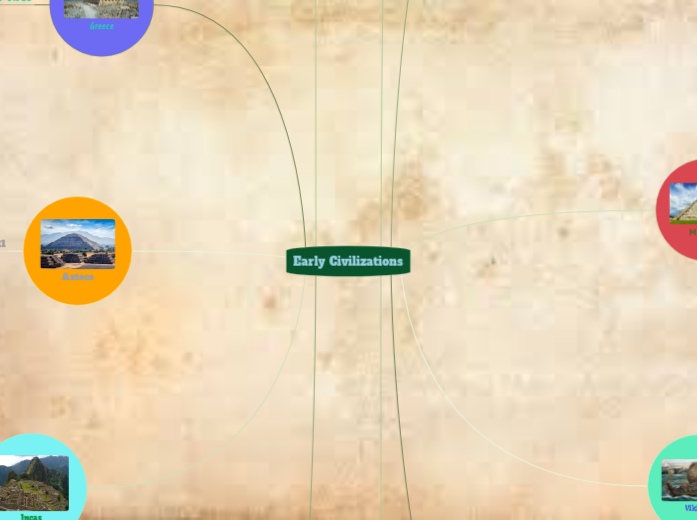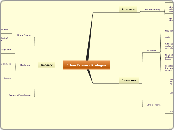Early Civilizations
4500 BCE - 637 AD
Mesopotamia
Main God of Mesopotamians : Anu
Climate : Mesopotamia
had a mostly desert
climate with hot summers
and mild winters. Mesopotamias
mountain regions, however, had very cold
winters and mild summers.
Landscape: The geography of Mesopotamia is diverse and falls into five main regions: the desert (west of the Euphrates), Upper Mesopotamia (between the upper Tigris and Euphrates rivers), the northern highlands of Iraq, Lower Mesopotamia, and the alluvial plain extending from around Tikrit to the Persian Gulf.
1438 CE- 1532 CE
Incas
Main God of Incas:Viracocha
Climate:The mountains
valleys had a year round
temperate and a humid
subtropical weather in costal areas
and rainforests in lowlands
Landscape:The geography
of Equador and Peru compromises
four distinct ecosystems:the
rough and rugged terrain of
the towering Andes mountains
in the center, the tropical
rainforests of the Amazon
to the east,the pacific lowland
to the west,and the sun laden
Galapogos islands of the coast.
1325-1521
Aztecs
Main God of Aztecs: Huitzilopochtli
Climate:All though low lying areas
of the twenty-fourth pararell were hot and humid
during the summer ,they usually have lower
temperature.
Landscape:Only a small amount
of rain passes through the mountain
range barriers to reach the interior that
includes grasslands at higher elevations
at the vast lowland of the Chihuaha desert.
1100 BCE- 146 BC
Greece
Main God of Greece: Zeus
Climate: Greece has a mediterranean
climate, with mild and wet winters in the southern
lowland and island regions and cold winters and strong
snowfalls in the mountanious areas in the central and northern regions and hot, dry summers.
Landscape: The mainland
has rugged mountains, forests
and lakes,but the country is also
widly known for the tiny islands
dotting the Agean sea to the
east, Mediterranean sea to the south,
and the Loanian sea to the west.
Subtopic
India
1500 BCE - 550 CE
Main God of India: Vishnu/ the god Shiva
Climate : The entirier region desplays a blend of wet and dry tropical weather, while the northern part shows hot and humid weather.
Landscape: Most of India forms a peninsuala
.The worlds highest mountain range, the Himalaya,
rises north.The south-east is borded by the bay of
Bengal and the southwest is borded by the Arabian sea.
Rome
27 BCE 476 CE
Main God of the Romans: Jupiter
cLIMATE: Rome had hot summers
and mild winters. Rome also
had a Mediterranean climate as
it had hot, dry summers and wet
cool winters.
Landscape: Rome's landscape is characterized by its unique geological features, advantageous location near the Tiber River and the Apennines mountain range, and transformation from swampy marshland to a livable space through drainage platforms and construction. Roman gardens were also an integral part of the city's landscape.
Celts
1200 BCE-400 CE
Main God of the Celts: Dagda
Climate: The Celts had mild summers
and cool winters. Celts who lived in
modern day Ireland experienced cooler
and wetter weather, while Celts living in
the south of modern day France experienced
hot and dry weather.
Landscape: Many Celtic tribes lived in hilly and mountainous regions, such as the Celtic tribes in modern day Ireland and Scotland.
Dense forests were common in Celtic lands,
providing resources for building and hunting.
Some Celtic settlements were located in fertile valleys and plains, wich were ideal for
agriculture. Coastal regions, especially in areas like Brittany (Modern day France) and
parts of modern day Ireland, were also inhabited by the Celts.
Vikings
793 CE 1066 CE
Main God of the Vikings: Odin
Climate: Although modern day Sweden's winter and summer temperature differences are extreme, the country generally enjoys a temperate climate, thanks to the Gulf Stream. From mild southern shores to Arctic northern landscapes, Sweden’s climate offers diverse experiences throughout the year.
Landscape: The Vikings were surrounded by
mountains and big forests, numerous lakes and
sandy ridges.
Mayans
2000 BCE- 1697 CE
Main god of the Mayans: Itzamna
The climate of the Mayans homes (Modern day Mesoamerica) was very diverse. The region was made up of mountain ranges and high plateaus in the center and north with a temperate and warm-humid climate, while in the Yucatecan Peninsula calcareous plains with low jungles and hot weather predominate. In the low-lying regions, sub-tropical and tropical climates were most common, as is true for most of the coastline along the Gulf of Mexico and the Caribbean Sea. The highlands showed much more climatic diversity, ranging from dry tropical to cold mountainous climates, the dominant climate was temperate with warm temperatures and moderate rainfall.
Landscape: Much of the Mayan heartland,
particulary in the Yucatan peninsuala and
modern day Guatemala, was covered in
dence tropical rainforests. The Mayans also
relied on water. Cenotes were especially
important. The water there was very scarce.
China
Main God of China: Shangdi
2070707070707
2110 BCE- 1766 BCE
Climate: China
experiences from high freezing
temperatures, to pretty hot weather.
Up in the North there is a frigid cold,
while in the south there is nice
tropical weather.
Landscape: Two-thirds of China's area was mountainous, including the Himalayas, which houses Mount Everest, the world's highest peak.
Egypt
3100 BCE - 30 BCE
Main God of Egyptians : Ra
Climate: Hot and dry. Egypt had a mild winter season
with rain falling around costal areas and a hot dry summer
season (May until September).
Landscape: southeastern Egypt's
landscape contains low mountain and desert.
Northeastern Egypt has wide valleys near the Nile
desert to the east and west.North of Cairo (The capital)
is the sprawling, triangular Nile river delta.









